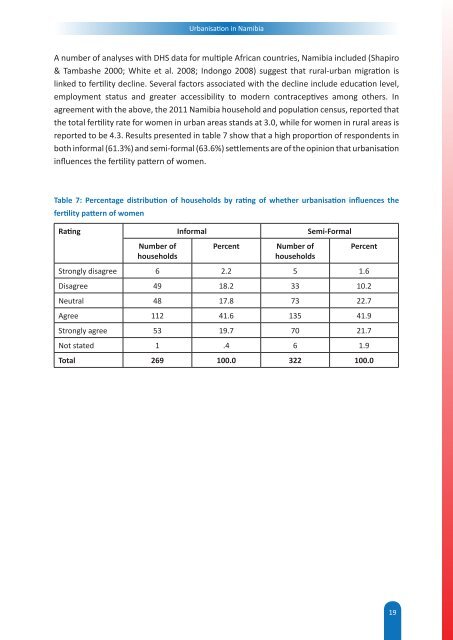Urbanisation-in-Namibia
Urbanisation-in-Namibia
Urbanisation-in-Namibia
Create successful ePaper yourself
Turn your PDF publications into a flip-book with our unique Google optimized e-Paper software.
<strong>Urbanisation</strong> <strong>in</strong> <strong>Namibia</strong>A number of analyses with DHS data for multiple African countries, <strong>Namibia</strong> <strong>in</strong>cluded (Shapiro& Tambashe 2000; White et al. 2008; Indongo 2008) suggest that rural-urban migration isl<strong>in</strong>ked to fertility decl<strong>in</strong>e. Several factors associated with the decl<strong>in</strong>e <strong>in</strong>clude education level,employment status and greater accessibility to modern contraceptives among others. Inagreement with the above, the 2011 <strong>Namibia</strong> household and population census, reported thatthe total fertility rate for women <strong>in</strong> urban areas stands at 3.0, while for women <strong>in</strong> rural areas isreported to be 4.3. Results presented <strong>in</strong> table 7 show that a high proportion of respondents <strong>in</strong>both <strong>in</strong>formal (61.3%) and semi-formal (63.6%) settlements are of the op<strong>in</strong>ion that urbanisation<strong>in</strong>fluences the fertility pattern of women.Table 7: Percentage distribution of households by rat<strong>in</strong>g of whether urbanisation <strong>in</strong>fluences thefertility pattern of womenRat<strong>in</strong>g Informal Semi-FormalNumber ofhouseholdsPercentNumber ofhouseholdsPercentStrongly disagree 6 2.2 5 1.6Disagree 49 18.2 33 10.2Neutral 48 17.8 73 22.7Agree 112 41.6 135 41.9Strongly agree 53 19.7 70 21.7Not stated 1 .4 6 1.9Total 269 100.0 322 100.019


